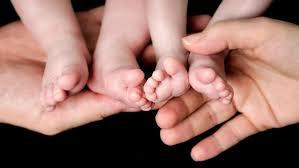
Women pregnant with twins need to time delivery just right, a research review suggests.
They need to minimize the risks that come with early arrivals yet still avoid the risk of stillbirths, which rises the longer multiples stay in the womb, the researchers say.
Pregnancy normally lasts about 40 weeks, and babies born after 37 weeks are considered full term. Earlier arrivals often have trouble breathing and digesting food as well as longer-term challenges such as impaired vision, hearing and cognitive skills as well as social and behavioral problems.
But twins are often delivered sooner because these babies have a higher risk of stillbirth – up to 13 times higher than singletons for twins that share a placenta and five times higher when the twins have separate placentas, researchers note in The BMJ.
Twins should be delivered at 37 weeks to minimize stillbirths and newborn deaths, the researchers conclude. There’s no evidence to support routine delivery before 36 weeks, the authors also note.
“It is advisable to continue the pregnancy, as long as the risk of stillbirth from prolonging pregnancy is lower than the risk of neonatal death from delivery,” said study author Dr. Shakila Thangaratinam, a researcher at Queen Mary University of London.
Current recommendations for the timing of twin deliveries vary, Thangaratinam and colleagues write in their report.
The American College of Obstetricians and Gynecologists (ACOG), for example, recommends delivery between 34 and 37 weeks for twins with a shared placenta and at 38 weeks for twins with separate placentas. Some other physician groups recommend delivery closer to 39 weeks with separate placentas.
To assess the optimal timing of twin deliveries, researchers analyzed data from 32 studies published within the past decade that included a total of 35,171 twin pregnancies. Most were twins with separate placentas, but in 5,486 pregnancies the twins shared a placenta.
Researchers assessed the rates of stillbirths as well as deaths within the first 28 days after deliveries at various gestational ages after 34 weeks.
With separate placentas, the risk of stillbirth from letting the pregnancy continue and the risk of death associated with early delivery were similar until 37 weeks gestation, the study found.
However, delaying delivery to 38 weeks gestation led to an additional 8.8 deaths per 1,000 due to an increase in stillbirths.
When twins shared a placenta, the risk of stillbirth appears to be higher than the risk of neonatal death once babies go beyond 36 weeks gestation, the study found.
It’s too soon to tell whether the findings would influence when doctors choose to deliver twins, said Dr. Joseph Wax, a researcher at Tufts University School of Medicine in Boston and Maine Medical Center in Portland who chairs ACOG’s committee on obstetric practice.
That’s because the timing is a delicate balance.
“Earlier delivery could increase the risk of neonatal death and other complications related to prematurity,” Wax, who wasn’t involved in the study, said by email.
“Later delivery could raise the risk of stillbirth, but still further reduce some complications resulting from early delivery,” Wax added.
The study shouldn’t change guidelines on delivery timing, said Dr. George Saade, chief of obstetrics and maternal-fetal medicine, The University of Texas Medical Branch.
“The recommendations are provided in a range because there are so many other factors to take into account,” Saade, who wasn’t involved in the study, said by email.
“Delivering at 37 weeks does not decrease other complications,” added Saade, chair of the health policy and advocacy committee for the Society for Maternal-Fetal Medicine. “It just lowers the chance of having a dead baby.”
Source: Reuters
 FR
FR EN
EN AR
AR








